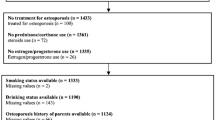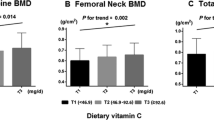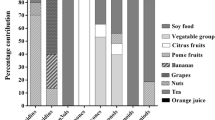Abstract
Summary
A cross-sectional analysis of 1,662 community dwelling elderly Japanese men suggested that habitual natto intake was significantly associated with higher bone mineral density (BMD). When adjustment was made for undercarboxylated osteocalcin levels, this association was insignificant, showing the natto–bone association to be primarily mediated by vitamin K.
Introduction
Low vitamin K intake is associated with an increased risk of hip fracture, but reports have been inconsistent on its effect on BMD. Our first aim was to examine the association between BMD and intake of fermented soybeans, natto, which contain vitamin K1 (20 μg/pack) and K2 (380 μg/pack). Our second aim was to examine the association between undercarboxylated osteocalcin (ucOC), a biomarker of vitamin K intake, and BMD to evaluate the role of vitamin K in this association.
Methods
Of the Japanese men aged ≥65 years who participated in the baseline survey of the Fujiwara-kyo Osteoporosis Risk in Men study, 1,662 men without diseases or medications known to affect bone metabolism were examined for associations between self-reported natto intake or serum ucOC levels with lumbar spine or hip BMD.
Results
The subjects with greater intake of natto showed significantly lower level of serum ucOC. Analysis after adjustment for confounding variables showed an association of greater intake of natto with both significantly higher BMD and lower risk of low BMD (T-score < −1 SD) at the total hip and femoral neck. This association became insignificant after further adjustment for ucOC level.
Conclusion
Habitual intake of natto was associated with a beneficial effect on bone health in elderly men, and this association is primarily due to vitamin K content of natto, although the lack of information on dietary nutrient intake, including vitamin K1 and K2, prevented us from further examining the association.
Similar content being viewed by others
References
Binkley NC, Suttie JW (1995) Vitamin K nutrition and osteoporosis. J Nutr 125:1812–1821
Feskanich D, Weber P, Willett WC, Rockett H, Booth SL, Colditz GA (1999) Vitamin K intake and hip fractures in women: a prospective study. Am J Clin Nutr 69:74–79
Booth SL, Tucker KL, Chen H, Hannan MT, Gagnon DR, Cupples LA, Wilson PW, Ordovas J, Schaefer EJ, Dawson-Hughes B, Kiel DP (2000) Dietary vitamin K intakes are associated with hip fracture but not with bone mineral density in elderly men and women. Am J Clin Nutr 71:1201–1208
Booth SL, Broe KE, Gagnon DR, Tucker KL, Hannan MT, McLean RR, Dawson-Hughes B, Wilson PW, Cupples LA, Kiel DP (2003) Vitamin K intake and bone mineral density in women and men. Am J Clin Nutr 77:512–516
Booth SL, Broe KE, Peterson JW, Cheng DM, Dawson-Hughes B, Gundberg CM, Cupples LA, Wilson PW, Kiel DP (2004) Associations between vitamin K biochemical measures and bone mineral density in men and women. J Clin Endocrinol Metab 89:4904–4909
Kamao M, Suhara Y, Tsugawa N, Uwano M, Yamaguchi N, Uenishi K, Ishida H, Sasaki S, Okano T (2007) Vitamin K content of foods and dietary vitamin K intake in Japanese young women. J Nutr Sci Vitaminol (Tokyo) 53:464–470
Kaneki M, Hodges SJ, Hosoi T, Fujiwara S, Lyons A, Crean SJ, Ishida N, Nakagawa M, Takechi M, Sano Y, Mizuno Y, Hoshino S, Miyao M, Inoue S, Horiki K, Shiraki M, Ouchi Y, Orimo H (2001) Japanese fermented soybean food as the major determinant of the large geographic difference in circulating levels of vitamin K2: possible implications for hip-fracture risk. Nutrition 17:315–321
Ikeda Y, Iki M, Morita A, Kajita E, Kagamimori S, Kagawa Y, Yoneshima H (2006) Intake of fermented soybeans, natto, is associated with reduced bone loss in postmenopausal women: Japanese Population-Based Osteoporosis (JPOS) Study. J Nutr 136:1323–1328
Furie B, Bouchard BA, Furie BC (1999) Vitamin K-dependent biosynthesis of gamma-carboxyglutamic acid. Blood 93:1798–1808
Ferland G (1998) The vitamin K-dependent proteins: an update. Nutr Rev 56:223–230
Gundberg CM, Nieman SD, Abrams S, Rosen H (1998) Vitamin K status and bone health: an analysis of methods for determination of undercarboxylated osteocalcin. J Clin Endocrinol Metab 83:3258–3266
Iwamoto J, Sato Y, Takeda T, Matsumoto H (2009) High-dose vitamin K supplementation reduces fracture incidence in postmenopausal women: a review of the literature. Nutr Res 29:221–228
Tsugawa N, Shiraki M, Suhara Y, Kamao M, Tanaka K, Okano T (2006) Vitamin K status of healthy Japanese women: age-related vitamin K requirement for gamma-carboxylation of osteocalcin. Am J Clin Nutr 83:380–386
Shearer MJ (1995) Vitamin K. Lancet 345:229–234
Iki M, Fujita Y, Tamaki J, Kouda K, Yura A, Kadowaki E, Sato Y, Moon JS, Okamoto N, Kurumatani N, Study Group for Functioning Capacity and Quality of Life in Elderly Japanese (Fujiwara-kyo Study Group) (2009) Design and baseline characteristics of a prospective cohort study for determinants of osteoporotic fracture in community-dwelling elderly Japanese men: the Fujiwara-kyo osteoporosis risk in men (FORMEN) study. BMC Musculoskelet Disord 10:165
Nathan H (1962) Osteophytes of the vertebral column. J Bone Joint Surg 44-A:243–269
Kanis JA, Melton LJ 3rd, Christiansen C, Johnston CC, Khaltaev N (1994) The diagnosis of osteoporosis. J Bone Miner Res 9:1137–1141
Craig CL, Marshall AL, Sjöström M, Bauman AE, Booth ML, Ainsworth BE, Pratt M, Ekelund U, Yngve A, Sallis JF, Oja P (2003) International physical activity questionnaire: 12-country reliability and validity. Med Sci Sports Exerc 35:1381–1395
Tomioka K, Hazaki K, Iwamoto J (2009) The cross-sectional study of daily step count, physical function and health-related Quality of Life for community-dwelling older adults. The 24th Research-Aid Report in medical and health science of Meiji Yasuda Life Foundation of Health and Welfare 24:1–11 (in Japanese)
Cockayne S, Adamson J, Lanham-New S, Shearer MJ, Gilbody S, Torgerson DJ (2006) Vitamin K and the prevention of fractures: systematic review and meta-analysis of randomized controlled trials. Arch Intern Med 166:1256–1261
Emaus N, Gjesdal CG, Almås B, Christensen M, Grimsgaard AS, Berntsen GK, Salomonsen L, Fønnebø V (2010) Vitamin K2 supplementation does not influence bone loss in early menopausal women: a randomised double-blind placebo-controlled trial. Osteoporos Int 21:1731–1740
Binkley N, Harke J, Krueger D, Engelke J, Vallarta-Ast N, Gemar D, Checovich M, Chappell R, Suttie J (2009) Vitamin K treatment reduces undercarboxylated osteocalcin but does not alter bone turnover, density, or geometry in healthy postmenopausal North American women. J Bone Miner Res 24:983–991
Booth SL, Dallal G, Shea MK, Gundberg C, Peterson JW, Dawson-Hughes B (2008) Effect of vitamin K supplementation on bone loss in elderly men and women. J Clin Endocrinol Metab 93:1217–1223
Volpe SL, Leung MM, Giordano H (2008) Vitamin K supplementation does not significantly impact bone mineral density and biochemical markers of bone in pre- and perimenopausal women. Nutr Res 28:577–582
Gundberg CM (2009) Vitamin K and bone: past, present, and future. J Bone Miner Res 24:980–982
Beavan SR, Prentice A, Stirling DM, Dibba B, Yan L, Harrington DJ, Shearer MJ (2005) Ethnic differences in osteocalcin gamma-carboxylation, plasma phylloquinone (vitamin K1) and apolipoprotein E genotype. Eur J Clin Nutr 59:72–81
Knapen MH, Schurgers LJ, Vermeer C (2007) Vitamin K2 supplementation improves hip bone geometry and bone strength indices in postmenopausal women. Osteoporos Int 18:963–972
Iki M, Dongmei N, Tamaki J, Sato Y, Kagamimori S, Kagawa Y, Yoneshima H (in press) For the Japanese Population-based Osteoporosis (JPOS) Study Group (2010) Age-specific reference values of hip geometric indices from a representative sample of the Japanese female population: Japanese Population-based Osteoporosis (JPOS) Study. Osteoporos Int 30
Schurgers LJ, Teunissen KJ, Hamulyák K, Knapen MH, Vik H, Vermeer C (2007) Vitamin K-containing dietary supplements: comparison of synthetic vitamin K1 and natto-derived menaquinone-7. Blood 109:3279–3283
Schurgers LJ, Vermeer C (2000) Determination of phylloquinone and menaquinones in food. Effect of food matrix on circulating vitamin K concentrations. Haemostasis 30:298–307
Harkness LS, Fiedler K, Sehgal AR, Oravec D, Lerner E (2004) Decreased bone resorption with soy isoflavone supplementation in postmenopausal women. J Womens Health (Larchmt) 13:1000–1007
Potter SM, Baum JA, Teng H, Stillman RJ, Shay NF, Erdman JW Jr (1998) Soy protein and isoflavones: their effects on blood lipids and bone density in postmenopausal women. Am J Clin Nutr 68:1375S–1379S
Tang BM, Eslick GD, Nowson C, Smith C, Bensoussan A (2007) Use of calcium or calcium in combination with vitamin D supplementation to prevent fractures and bone loss in people aged 50 years and older: a meta-analysis. Lancet 370:657–666
Lee NK, Sowa H, Hinoi E, Ferron M, Ahn JD, Confavreux C, Dacquin R, Mee PJ, McKee MD, Jung DY, Zhang Z, Kim JK, Mauvais-Jarvis F, Ducy P, Karsenty G (2007) Endocrine regulation of energy metabolism by the skeleton. Cell 130:456–469
Kanazawa I, Yamaguchi T, Yamauchi M, Yamamoto M, Kurioka S, Yano S, Sugimoto T (2010) Serum undercarboxylated osteocalcin was inversely associated with plasma glucose level and fat mass in type 2 diabetes mellitus. Osteoporos Int. (in press)
Hwang YC, Jeong IK, Ahn KJ, Chung HY (2009) The uncarboxylated form of osteocalcin is associated with improved glucose tolerance and enhanced beta-cell function in middle-aged male subjects. Diabetes Metab Res Rev 25:768–772
Yoshida M, Jacques PF, Meigs JB, Saltzman E, Shea MK, Gundberg C, Dawson-Hughes B, Dallal G, Booth SL (2008) Effect of vitamin K supplementation on insulin resistance in older men and women. Diab Care 31:2092–2096
Steiger P, Cummings SR, Black DM, Spencer NE, Genant HK (1992) Age-related decrements in bone mineral density in women over 65. J Bone Miner Res 7:625–632
Acknowledgments
The Fujiwara-kyo Study Group, chaired by Norio Kurumatani with Nozomi Okamoto as a secretary general comprising Nobuko Amano, Yuki Fujita, Akihiro Harano, Kan Hazaki, Masayuki Iki, Junko Iwamoto, Akira Minematsu, Masayuki Morikawa, Keigo Saeki, Noriyuki Tanaka, Kimiko Tomioka, and Motokazu Yanagi, performed most non-skeletal measures in the present study and provided the data to the FORMEN study. The FORMEN study was supported by several grants as follows: Grants-in-Aid for Scientific Research (no. 20659103: 2008–2009, no. 21390210: 2009–2011, no. 20590661: 2008–2010) from the Japanese Society for the Promotion of Science, a Grant-in-Aid for Young Scientists (no. 20790451: 2008–2010) from the Japanese Ministry of Education, Culture, Sports, Science and Technology; a Grant-in-Aid for Study on Milk Nutrition (2008) from the Japan Dairy Association; a grant (2007) from the Foundation for Total Health Promotion; a St. Luke's Life Science Institute Grant-in-Aid for Epidemiological Research (2008); and a grant (2008) from the Physical Fitness Research Institute, MEIJIYASUDA Life Foundation of Health and Welfare. The authors acknowledge Eisai Co. Ltd. (Tokyo, Japan) and Sanko Junyaku Co. Ltd. (Tokyo, Japan) for their cooperation in measuring ucOC in sera, Toyukai Medical Corporation (Tokyo, Japan) and Toyo Medic Inc., (Osaka, Japan) for DXA scanning, and SRL Inc. (Tokyo, Japan) for their technical assistance in laboratory measurements.
Conflicts of interest
None.
Author information
Authors and Affiliations
Corresponding author
Rights and permissions
About this article
Cite this article
Fujita, Y., Iki, M., Tamaki, J. et al. Association between vitamin K intake from fermented soybeans, natto, and bone mineral density in elderly Japanese men: the Fujiwara-kyo Osteoporosis Risk in Men (FORMEN) study. Osteoporos Int 23, 705–714 (2012). https://doi.org/10.1007/s00198-011-1594-1
Received:
Accepted:
Published:
Issue Date:
DOI: https://doi.org/10.1007/s00198-011-1594-1




